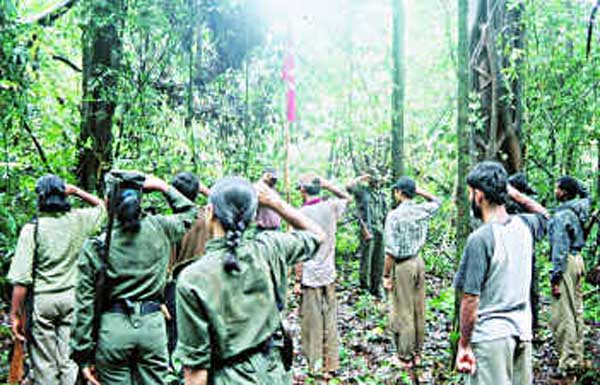Among the security perils that afflict India internally, the gravest and most alarmingly burgeoning is left-wing extremism (LWE), commonly dubbed as the Naxal-Maoist threat. Alluded to as being the most serious internal security challenge by Prime Minister Manmohan Singh on more than one occasion, the LWE threat currently spans nearly 170 districts spread over 16 states, with a wide swathe running in the centre of the Indian hinterland from the Nepal-Bihar border to the Karnataka and Kerala borders in a south-west orientation referred to as “The Red Corridor.” This vast region traverses a geographical expanse also referred to by some as “from Pashupatinath in Nepal to Tirupatinath in Andhra Pradesh”! That these extremists have unambiguously and frequently pronounced their objective to seize power in India by a protracted war against the Indian state must never be underplayed. That some areas within the “Red Corridor” are already totally bereft of any governmental presence and control, referred to as “liberated zones” by these militants should be a cause of serious concern to the governments both at national and state levels. That this serious challenge to India’s security has well-established and deliberately planned cross-border linkages compounds the already serious ramifications of LWE in India.
It is evident that LWE operations will be well planned and executed as part of a coordinated strategy by the LWE leadership.
The term “Naxalism” refers to the LWE movement, which traces its origins to the May 1967 peasant uprising at Naxalbari, in the Darjeeling district of West Bengal. This movement was initially spearheaded by the Communist Party of India (Marxist) (CPI-M) leaders Charu Mazumdar and Kanu Sanyal to primarily address the local problems of landless, marginal farmers and farm labour from rapacious feudal landlords. In April 1969, a split occurred in the party and a more radical platform was adopted by the new formation, the Communist Party of India (Marxist-Leninist) (CPI-ML), which drew its inspiration and ideology from the thoughts of Mao-Tse-Tung, with Charu Mazumdar proclaiming its mission as the “physical annihilation of class enemies.” Though initially it spread to a large number of districts of West Bengal and some tribal belts in other states, especially the Telengana region in Andhra Pradesh, strong police action and the death of Charu Mazumdar in 1972 led to the movement losing its initial momentum.
However, the Naxal movement in India entered a decisive phase of transformation with the merger in September 2004 of the two leading leftist extremist organisations, namely the People’s War Group (PWG) and the Maoist Communist Centre of India (MCCI), metamorphosing into the Communist Party of India (Maoist) (CPI-Maoist). Today, these militant groups are together taking on the Indian state in the pursuit of their secessionist and violent agendas in the garb of fighting for the rights of the tribals and other deprived sections of society. In June 2009, the Government of India banned CPI-Maoist under the Unlawful Activities (Prevention) Act as a terrorist organisation. The group was charged with running an extortion economy in the guise of a popular revolution and extorting money from mining companies and various businesspersons apart from blowing up schools, police posts and scantily guarded railway stations and targeting governmental functionaries and local police personnel to scare them away from their areas of responsibilities.
Over the years, after embracing Naxal, Maoist, CPI-ML and PWG cadres, LWE has now grown into a widely dispersed yet interlinked, vehemently anti-democratic and gruesomely violent movement that aims to overthrow democratically elected governments and all state institutions all across the country. The Central Committee (CC) of the party formulated its plans for reorganising its structure at the 9th Unity Congress held in January–February 2011.1 According to some estimates, CPI-Maoist has surreptitiously established four regional bureaus for the country’s landmass and these regions are further subdivided into state, special zonal and special area committee jurisdictions – a well-established network to dispense immediate justice to the common folk through its janathans sarkars (people’s courts), collect/extort money and plan and implement its violent agendas against the state. In “the military realm, on the analogy of Regional Bureaus, the CC also has established two Regional Commands(RCs) to undertake and coordinate large scale operations over and above the State Level Military Commissions.”2 Thus, it is evident that LWE operations will be well planned and executed as part of a coordinated strategy by the LWE leadership.
By conservative estimates, this movement has nearly 50,000 highly motivated armed cadres, many well-trained in the use of improvised explosive devices (IEDs) and landmines and equipped with sophisticated smuggled small arms automatic weaponry from China (across the Indo-Myanmar border); from Bangladesh; and, importantly, from across the Indo-Nepal border, from ISI-sponsored agents. In addition, media reports quoting both Research and Analysis Wing (RAW) and Military Intelligence (MI) sources confirm the linkages of Naxal-Maoists with insurgents from Manipur, militants residing in Myanmar with Chinese links and ULFA militants in Bangladesh and, above all, extremely close all- embracing linkages with Nepalese Maoists.3
Reportedly, the LWE hierarchy has a budget, based on an extortion economy of over 1,500 crores, to propel its violent struggles against the Indian state. Overall, LWE has by now unmistakably developed into a malignant cancer engulfing in varying intensities nearly one-third of the country. Not less than 48 districts in Chhattisgarh, Jharkhand, Odisha, West Bengal, Bihar and Maharashtra have been more than seriously affected. LWE has even spread its tentacles to the faraway Assam. It has also come to light that Naxal outfits plan to use the Western Ghats straddling the states of Maharashtra, Goa, Karnataka and Kerala to create another Compact Revolutionary Zone (CRZ) on the lines of the main one created along the eastern corridor of the country.4
…the Naxal ability to strike at will or carry out abductions of governmental functionaries and destroy schools/railways and communication infrastructure remains as potent as earlier.
That in the “Red Corridor,” even newly well-equipped police detachments trained to combat LWE have taken large casualties is nothing surprising. Over 11,000 civilian and police fatalities have resulted in the last five years owing to LWE violence. The Dantewada massacre in April 2010 in Chhattisgarh, which resulted in 76 casualties to security personnel, is a classic case of the reach of the militants and equally the lack of operational preparedness of our counter-insurgency police forces. From 2001 to 2012, about 5,772 civilians and 2,065 security personnel have been killed in India owing to Naxal-Maoist violence.5 A majority of the civilians killed are tribals, and many are from the underprivileged sections of society, often branded as “police informers.” Overall, however, the number of Naxal-related incidents and casualties has gone down owing to better coordination between the centre and states and a substantial number of personnel/units from the central police organisations having been deployed in the affected areas. Nevertheless, the Naxal ability to strike at will or carry out abductions of governmental functionaries and destroy schools/railways and communication infrastructure remains as potent as earlier.
LWE in Urban Centres
Though LWE has energised itself primarily in forest areas and areas characterised by lack of governance (countless that there are), the Naxal-Maoist leadership felt that urban centres have remained largely untouched by LWE. In January 2009, LWE’s Central Committee had prepared an Urban Perspective Document for extending its reach to urban centres where a growing number of the urban poor, especially the youth, are afflicted with poverty, unemployment and general disaffection and thus are a natural reservoir for recruitment into the Maoist cadres.
LWE’s new strategy focuses on a six-stage approach dubbed “SAARC,” namely, survey, awareness, agitation, recruitment, resistance and control. The Maoist document “Strategy and Tactics of the Indian Revolution” (STIR) opines that “Work in the urban areas has a special importance in our revolutionary work. . . . [I]n our revolution, which follows the line of protracted people’s war, the liberation of urban areas, will be possible only in the last stage of the revolution.”6 It can thus be surmised that if the nation and its security organs are not vigilant, it is a matter of time that LWE will stir credible trouble in urban areas in the coming years.
Causes: Growth of Naxal-Maoists in India
As the nation braces to get rid of this scourge, it will only be prudent to introspect the reasons of growth of LWE insurgency in India. By any reckoning, LWE in India has materialised in its present alarming dimension owing to a variety of reasons since independence. These are lack of a clear national policy in combating indigenous insurgencies; political differences between many states and the national government; woefully poor intelligence, especially at the ground level; ill-equipped, under-trained, and poorly motivated police and central police forces; lack of coordination among state and central security agencies; and, above all, a total neglect of locally significant development and legal issues in the insurgency-infested regions.
…even after 65 years of our independence, there are thousands of villages in the hinterland without any road connectivity, clean drinking water facility, schools, hospitals, post office, police station or other government institutions! This vacuum has been filled by the Naxals…
The most state governments have not implemented the various forest laws and the land ceiling laws enacted as early as in 1955 to safeguard the basic rights of tribals and the poor in rural areas has compounded and fuelled the problem of growing insurgency in the extremely poor regions of the country. It is not surprising that even some well-educated young men and women have been drawn to the Naxal movement, more on idealism or romantic grounds, in total ignorance of the stark facts that exist about this otherwise extremely violent and seditious struggle against the Indian state.
It is important to understand the nuances of the Fifth and Ninth Schedules of the Constitution enacted in 1950. The Fifth Schedule had stipulated that governors of the states would administer the tribal areas in their respective states by appointing Tribal Advisory Councils. The Ninth Schedule dealt with the equitable distribution of cultivable land by enacting land ceiling laws and distributing surplus land among the landless labourers. Amazingly, only three states –Jammu and Kashmir, West Bengal and Kerala – have implemented this constitutional imperative. This means that “all the actions taken by the states through the Forest Department in granting mining leases in forests where Adivasis were living in their state are illegal and unlawful and ultravires of the Constitution of India.”7
Among the other major causative factors for the growth of Naxal-Maoism are that since India’s independence, the fruits of development have not trickled down to the vast marginalised sections of Indian society and the disparity in living conditions in the vast layers of our society is not only huge, inhuman, inexplicable and growing but unbridgeable. The state is seen by many among the poor as exploitative of their interests while safeguarding the well-being of a few. In addition, India’s ancient caste system has also led to social discrimination, economic exploitation, the practice of bonded labour and the use of people belonging to the so-called lower castes in some areas of the nation for purely menial tasks, which creates a natural breeding ground for the spread of left-wing ideology. Nevertheless, the major singular factor unmistakably is the total lack of development and governance in some of these now Maoist-Naxal-infested regions in the country. Surprisingly, even after 65 years of our independence, there are thousands of villages in the hinterland without any road connectivity, clean drinking water facility, schools, hospitals, post office, police station or other government institutions! This vacuum has been filled by the Naxals, who run a near-parallel administration and go around dispensing immediate justice, levying collection and recruiting many willing and unwilling heads into their leftist fold to take on the police-landlord-politician-contractor nexus.
Current Governmental Plans to Manage LWE
Since the past few years, the centre has endeavoured to adopt a holistic approach to tackle the menace of LWE. This has seen liberal assistance in capacity building, deployment of central police forces, generous allocation of security-related expenditure to the affected states, better equipping and training of special police forces for counter-insurgency operations and construction of specialised infrastructure and fortified police stations. A number of review and monitoring mechanisms have been established by the central government. In addition, a standing committee of the chief ministers of the states affected by LWE has been set up under the chairmanship of the union home minister to achieve better coordination among the states. The union home secretary presides over a coordination centre with the chief secretaries and directors general of police of the various states while a high-powered review group under the cabinet secretary oversees macro security and interstate issues. In addition, the Member Secretary Planning Commission oversees the effective implementation of the development schemes in the affected areas. In addition, a unified command has also been set up in the states of Chhattisgarh, Jharkhand, Odisha and West Bengal, with officers from the civil administration, the police and the paramilitary to jointly strategize anti-Naxal operations and oversee development projects in their areas of responsibilities.
The Chhattisgarh government, however, handled its situation firmly, executed the so-called Operation Greenhunt with sincerity and did not release any of the captured Maoist cadres despite political pressures.
The centre’s Integrated Action Plan and Road Requirement Plans-I have made some inroads into the development of remote regions after years of neglect. As the government allocates additional funding for special development projects, it must scrupulously ensure that funds are being properly used on the ground and not being misappropriated by corrupt elements in the states, as some NGOs have pointed out.
After Pakistan’s ISI-inspired terror attack in Mumbai in November 2009, P. Chidambaram was installed as the new home minister and did a commendable job of giving clarity and direction to the centre’s Naxal policy. He summarised the government’s response in three graphic words – Clear, Hold and Develop – which involves clearing the Maoists-Naxals from their swamps by undertaking offensive operations against them, establishing the writ of the civil administration in these areas and then making concerted efforts to ensure the much required economic development of these areas. Though this strategy is by itself sound, its implementation by some of the LWE-affected states has been tardy, at times even on political grounds. The Chhattisgarh government, however, handled its situation firmly, executed the so-called Operation Greenhunt with sincerity and did not release any of the captured Maoist cadres despite political pressures.8 Both Bihar’s and West Bengal’s chief ministers (Nitish Kumar and Mamata Banerjee, respectively) appeared unenthusiastic about adopting the centre’s approach, and the Odisha government virtually capitulated to the Maoist militants by releasing a large number of the Maoist cadres who had been earlier captured by its police and paramilitary units.9 Earlier, the Andhra Pradesh state government had done well in combating the Naxals by establishing a dedicated and well-equipped counter-insurgency outfit, the Greyhounds – a step worthy of emulation by other states also.
Suggested Future Response
There is no doubt that the nation and the central government (far more than some state governments) are more than seized of the LWE malaise and the havoc it can create to the national security environment if not tackled with firmness, alacrity and the collective wisdom and resources of both the centre and the state governments, even some unwilling ones. The Government of India – with the experience of combating myriad insurgencies, including foreign sponsored and aided, successfully and not so successfully – thus needs to conceive, discuss, war-game, formulate and then implement a comprehensive national strategy embracing the security, political and socio-economic dimensions of the problem to confront LWE, which is truly a multidimensional problem. Importantly, all stakeholders, including central institutions, state governments, political parties of all hues, intelligence agencies, police and central police organisations, paramilitary forces, NGOs, social workers, educational institutions and captains of industry, will have to be taken on board and their visions and activities synergised. In addition, non-Congress state governments must not oppose the establishment of essential mechanisms, like the National Counter Terrorism Centre, and whatever reservations they have can be mutually sorted out in the larger national interest to together combat Naxal-Maoist terror.
It is a matter of gratification that the government has rightly abjured the employment of the Indian army and the Indian air force against its own citizens for the time being. The air force can be gainfully employed for reconnaissance, speedy transportation of troops, logistics, evacuation of casualties, etc., while the Indian army can continue, now in larger measure, to train the police, central police personnel and the paramilitary in counter-insurgency operations. The Ministry of Home Affairs will do well to absorb in its forces a large number of able-bodied and motivated retired ex-servicemen, including from the Corps of Engineers (especially for anti-IED/mine tasks) in counter-insurgency operations. This well-trained national resource must not be wasted.
As a start, police forces, other central agencies and even the armed forces can recruit, in large numbers, people from these poverty-afflicted regions and get them into the national mainstream – a privilege they have been long denied.
The criticality of counter-insurgency operations in the nation also warrants, under the Ministry of Home Affairs, a dedicated minister of state primarily dealing with internal security, who can, at the macro level, synergise all matters, operational, training, logistics, inter-agency coordination and, importantly, centre-state coordination. In addition, the government may wish to review the constitutional provisions of still keeping law and order exclusively under the State List or shifting it to the Concurrent List as law and order problems are, in a majority of the cases, getting difficult for states to handle on their own.
Conclusion
To merely attribute the spread of LWE to socio-economic reasons like lack of development in the regions affected will be rather simplistic. At the moment, when the Maoists-Naxals have explicitly refused to talk to the government and are indulging in the worst form of violence not only against the police forces but also against innocent civilians and lower functionaries of the state, the sole priority of the government should be to take these terrorists head-on and eliminate and jail as many as possible without causing collateral damage to own civilians and villagers in the regions affected. The stated policy of “Clear, Hold and Build” is eminently workable, provided there is synergy in action between the political and security elements at the state, national and regional levels.
The nation has only one choice, and that is to speedily and jointly combat and defeat the LWE cadres before full-scale insurgencies erupt at many places within the country. A five-year immediate-action plan and a 20-year, long-term-perspective plan need to be conceptualised and taken to their logical conclusion. These plans to defeat the Naxal-Maoist menace will have to be an amalgam of the three non-negotiable pillars: security for all, equitable development and genuine and compassionate political and economic rehabilitation of those who surrender to the state. The overriding principle should be to encourage full utilisation of local genius and resources. As a start, police forces, other central agencies and even the armed forces can recruit, in large numbers, people from these poverty-afflicted regions and get them into the national mainstream – a privilege they have been long denied.
Despite our many endemic failings and the machinations of some terror-exporting neighbours, it is a matter of some satisfaction that India has successfully managed and contained insurgencies in Jammu and Kashmir (notwithstanding Pakistan’s persistent efforts to keep the pot boiling there) and the Northeast. Thus, defeating LWE also should not be impossible for a nation that aspires to be in global reckoning.
Notes and References
Reference: Ministry of Home Affairs Report on Left Wing Extremism 2011-2012
- Shekhar Adhikari. Defence and Security Alert, June 2012. pp. 76–78.
- Ibid.
- http:// week.manoramaonline.com
- Shekhar Adhikari as quoted in serial 1 and 2 above.
- The official website of the Ministry of Home Affairs, Government of India.
- Maoist Document: Strategy and Tactics of the Indian Revolution (widely circulated).
- E. N. Rammohan. The Defence and Security Alert, June 2012. p. 22.
- Prakash Singh. The Defence and Security Alert, June 2012. pp. 12–13.
- Ibid.








Good evening sir,
I am a civil aspirant and a resident of Lucknow city. Having learned so far about internal security as a subject I came across that naxalism is grown much more due do mishandling and low political will by our so called leadership. Your above mentioned blog on naxalism told me the problem and causes of the naxalism growth so far.
Sir please provide me the guidance for the combating efforts to tackle these kinds of internal security threat.?
As a administrator should someone go hard on the problem of this type as I think being hard on naxalism would create more of it by showing them as martyr or victim.?
Should we go soft on it as this could lead it to broaden up their network behind the scenes and would ultimately worsen the situation.!!
So what is the best tactic to get rid of this problem and problems of the similar nature.
Your guidance would be invaluable to me sir.
Regards
Shashidhar mishra
Cell no 0 9450338619